The Role of Health Literacy in Aboriginal Women's Health: An Analysis
VerifiedAdded on 2023/06/07
|10
|2755
|150
Essay
AI Summary
This essay examines the critical role of health literacy in the health outcomes of Aboriginal women in Australia, focusing particularly on maternal health. It highlights the disparities in maternal mortality rates between Aboriginal and non-Aboriginal women, attributing these differences partly to inadequate health literacy. The essay discusses how a lack of understanding regarding healthcare services, nutrition, and the risks associated with behaviors like smoking and alcohol consumption during pregnancy significantly impacts both maternal and infant health. It further explores the potential of registered nurses to bridge this gap through culturally competent care, health promotion activities, and the development of health literacy among pregnant Aboriginal women. The essay concludes by emphasizing the importance of improving health literacy to enhance the overall well-being of Aboriginal women and their children, alongside governmental efforts to address social determinants of health.
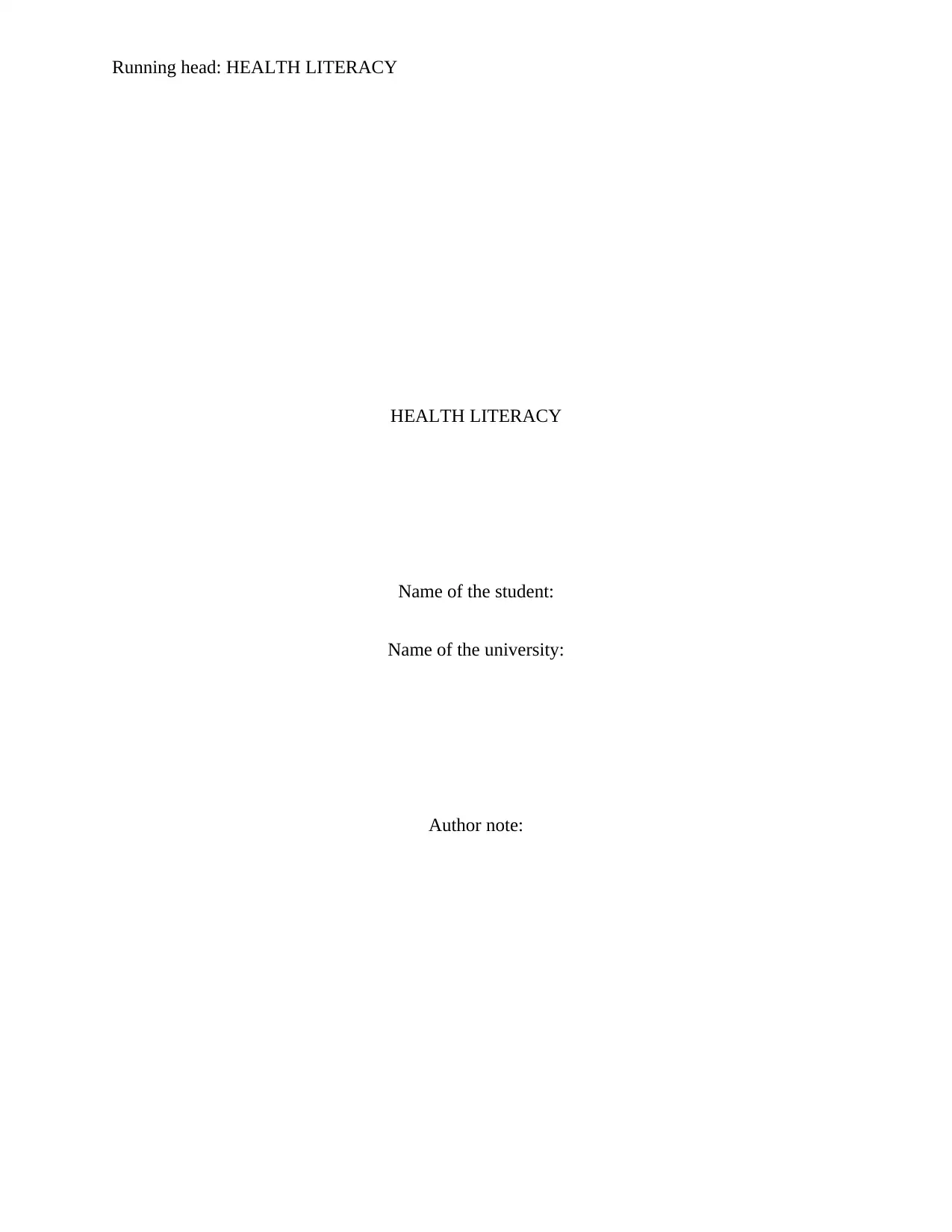
Running head: HEALTH LITERACY
HEALTH LITERACY
Name of the student:
Name of the university:
Author note:
HEALTH LITERACY
Name of the student:
Name of the university:
Author note:
Paraphrase This Document
Need a fresh take? Get an instant paraphrase of this document with our AI Paraphraser

1
HEALTH LITERACY
Health literacy can be described as the degree to which the individuals are seen to have
the capacity of obtaining, processing and thereby developing an understanding about the basic
health information and the different services important for maintaining healthcare decisions. This
assignment will depict one of the most vulnerable cohorts in the nation of Australia and will
show how lack of health literacy had affected their health and the future of the coming
generations. It will also show how registered nurses might help in such situations.
Studies have shown that health literacy is dependent on a number of systemic as well as
individual factors (Batterham et al., 2016). These are the communication skills of the laypersons
as well as the professionals and the second factor is the lay and professional knowledge of the
health topics. The other factors are the culture, demands of the healthcare and the public
healthcare systems and the demands of the situations and the context. Studies have also
suggested that the health literacy can affect the ability of the individuals in navigating the
healthcare systems that include filling out complex forms as well as locating different providers
and services (Beauchamp et al., 2015). It also determines the ability of individuals in sharing
their personal information like that of the health history with the providers and engaging in
proper self-care and chronic disorder management. It also helps individuals in understanding
mathematical concepts like that of the probability as well as risks.
In addition to the different types of basic literacy skills, health literacy also requires
knowledge of the different healthcare topics. People who do not have proper heath literacy is
seen to lack knowledge about their health conditions and they are also seen to harbor
misinformation about their body and the nature and causes of the disorders. Without this
knowledge, the individuals can never understand the relationship between the healthcare lifestyle
factors like that of the physical exercise and diet with that of the various health outcomes
HEALTH LITERACY
Health literacy can be described as the degree to which the individuals are seen to have
the capacity of obtaining, processing and thereby developing an understanding about the basic
health information and the different services important for maintaining healthcare decisions. This
assignment will depict one of the most vulnerable cohorts in the nation of Australia and will
show how lack of health literacy had affected their health and the future of the coming
generations. It will also show how registered nurses might help in such situations.
Studies have shown that health literacy is dependent on a number of systemic as well as
individual factors (Batterham et al., 2016). These are the communication skills of the laypersons
as well as the professionals and the second factor is the lay and professional knowledge of the
health topics. The other factors are the culture, demands of the healthcare and the public
healthcare systems and the demands of the situations and the context. Studies have also
suggested that the health literacy can affect the ability of the individuals in navigating the
healthcare systems that include filling out complex forms as well as locating different providers
and services (Beauchamp et al., 2015). It also determines the ability of individuals in sharing
their personal information like that of the health history with the providers and engaging in
proper self-care and chronic disorder management. It also helps individuals in understanding
mathematical concepts like that of the probability as well as risks.
In addition to the different types of basic literacy skills, health literacy also requires
knowledge of the different healthcare topics. People who do not have proper heath literacy is
seen to lack knowledge about their health conditions and they are also seen to harbor
misinformation about their body and the nature and causes of the disorders. Without this
knowledge, the individuals can never understand the relationship between the healthcare lifestyle
factors like that of the physical exercise and diet with that of the various health outcomes
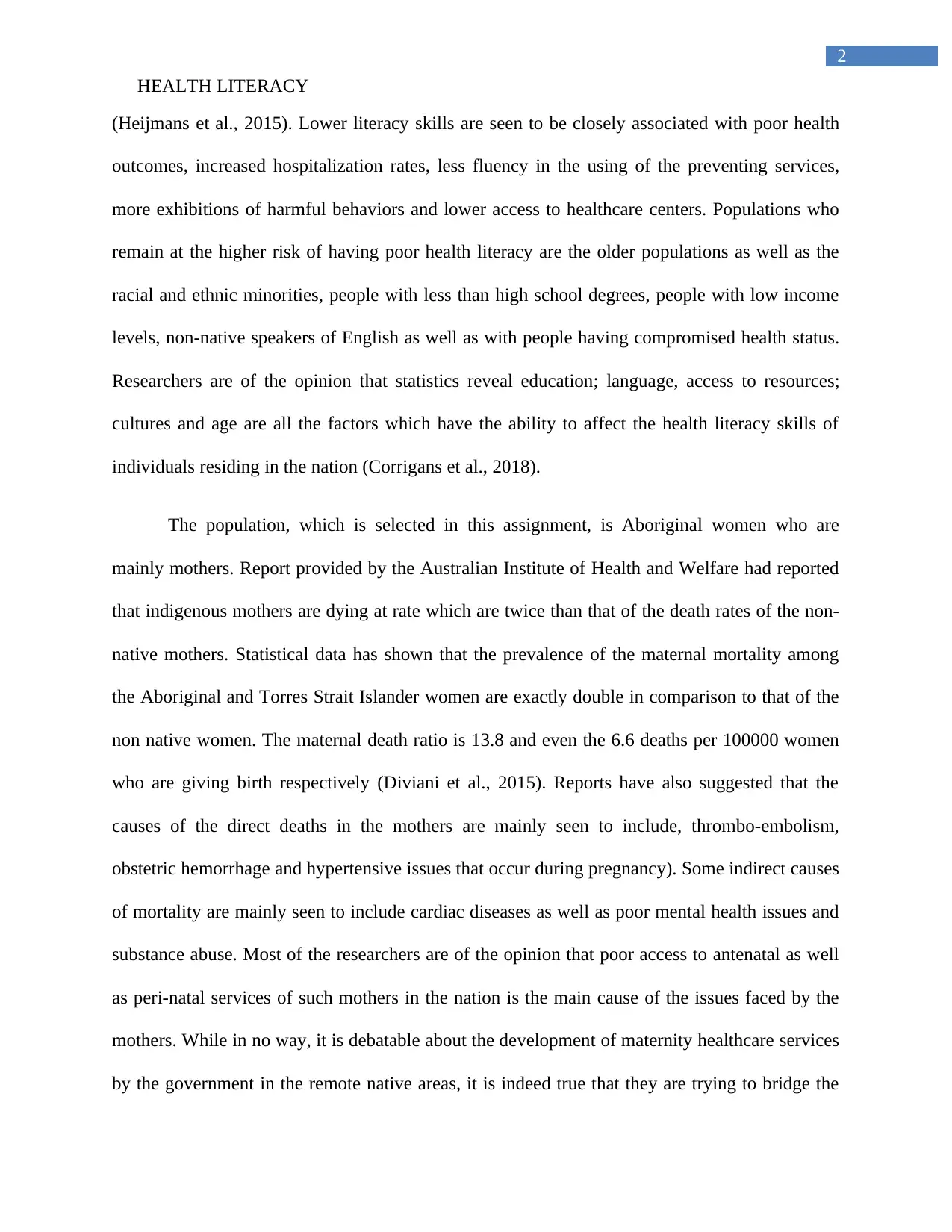
2
HEALTH LITERACY
(Heijmans et al., 2015). Lower literacy skills are seen to be closely associated with poor health
outcomes, increased hospitalization rates, less fluency in the using of the preventing services,
more exhibitions of harmful behaviors and lower access to healthcare centers. Populations who
remain at the higher risk of having poor health literacy are the older populations as well as the
racial and ethnic minorities, people with less than high school degrees, people with low income
levels, non-native speakers of English as well as with people having compromised health status.
Researchers are of the opinion that statistics reveal education; language, access to resources;
cultures and age are all the factors which have the ability to affect the health literacy skills of
individuals residing in the nation (Corrigans et al., 2018).
The population, which is selected in this assignment, is Aboriginal women who are
mainly mothers. Report provided by the Australian Institute of Health and Welfare had reported
that indigenous mothers are dying at rate which are twice than that of the death rates of the non-
native mothers. Statistical data has shown that the prevalence of the maternal mortality among
the Aboriginal and Torres Strait Islander women are exactly double in comparison to that of the
non native women. The maternal death ratio is 13.8 and even the 6.6 deaths per 100000 women
who are giving birth respectively (Diviani et al., 2015). Reports have also suggested that the
causes of the direct deaths in the mothers are mainly seen to include, thrombo-embolism,
obstetric hemorrhage and hypertensive issues that occur during pregnancy). Some indirect causes
of mortality are mainly seen to include cardiac diseases as well as poor mental health issues and
substance abuse. Most of the researchers are of the opinion that poor access to antenatal as well
as peri-natal services of such mothers in the nation is the main cause of the issues faced by the
mothers. While in no way, it is debatable about the development of maternity healthcare services
by the government in the remote native areas, it is indeed true that they are trying to bridge the
HEALTH LITERACY
(Heijmans et al., 2015). Lower literacy skills are seen to be closely associated with poor health
outcomes, increased hospitalization rates, less fluency in the using of the preventing services,
more exhibitions of harmful behaviors and lower access to healthcare centers. Populations who
remain at the higher risk of having poor health literacy are the older populations as well as the
racial and ethnic minorities, people with less than high school degrees, people with low income
levels, non-native speakers of English as well as with people having compromised health status.
Researchers are of the opinion that statistics reveal education; language, access to resources;
cultures and age are all the factors which have the ability to affect the health literacy skills of
individuals residing in the nation (Corrigans et al., 2018).
The population, which is selected in this assignment, is Aboriginal women who are
mainly mothers. Report provided by the Australian Institute of Health and Welfare had reported
that indigenous mothers are dying at rate which are twice than that of the death rates of the non-
native mothers. Statistical data has shown that the prevalence of the maternal mortality among
the Aboriginal and Torres Strait Islander women are exactly double in comparison to that of the
non native women. The maternal death ratio is 13.8 and even the 6.6 deaths per 100000 women
who are giving birth respectively (Diviani et al., 2015). Reports have also suggested that the
causes of the direct deaths in the mothers are mainly seen to include, thrombo-embolism,
obstetric hemorrhage and hypertensive issues that occur during pregnancy). Some indirect causes
of mortality are mainly seen to include cardiac diseases as well as poor mental health issues and
substance abuse. Most of the researchers are of the opinion that poor access to antenatal as well
as peri-natal services of such mothers in the nation is the main cause of the issues faced by the
mothers. While in no way, it is debatable about the development of maternity healthcare services
by the government in the remote native areas, it is indeed true that they are trying to bridge the
⊘ This is a preview!⊘
Do you want full access?
Subscribe today to unlock all pages.

Trusted by 1+ million students worldwide
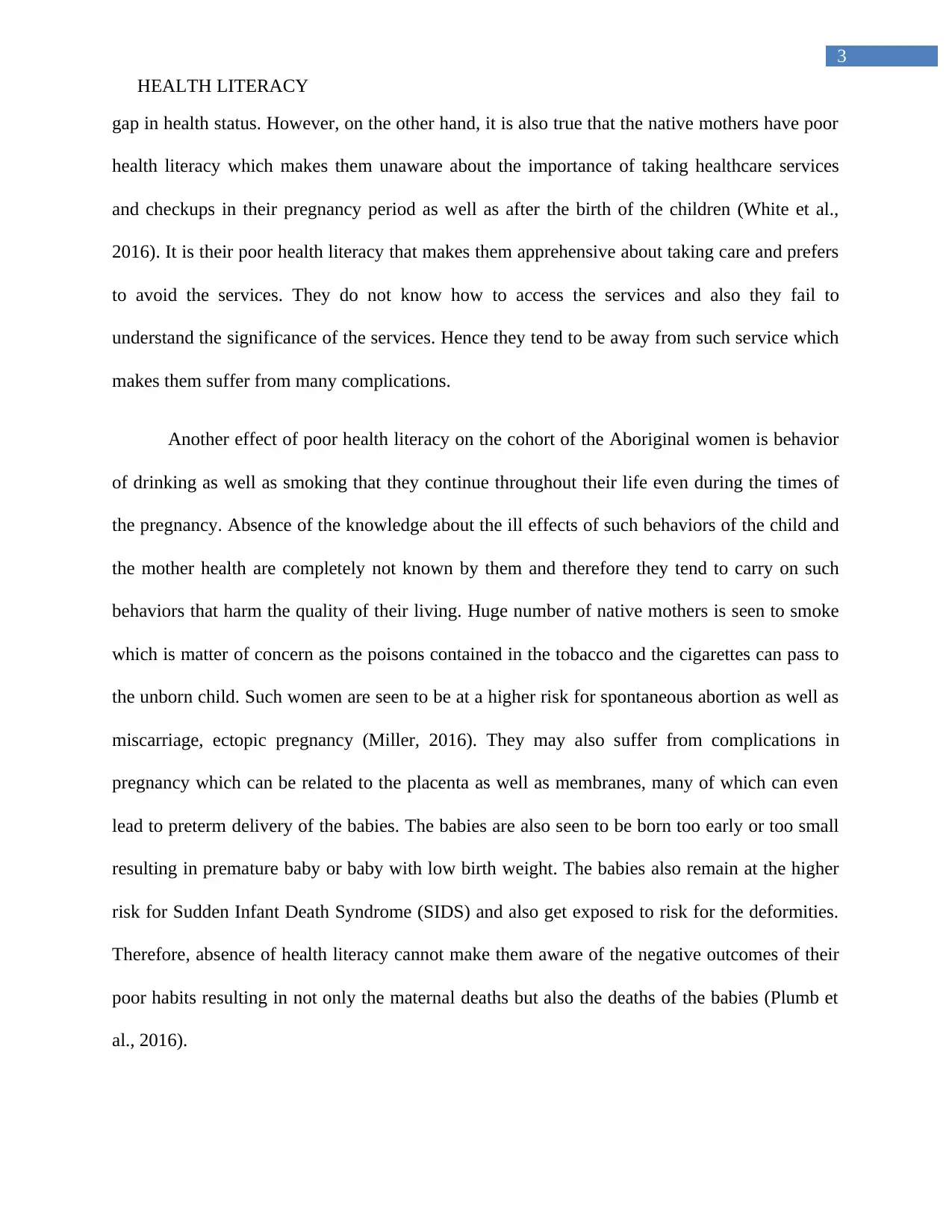
3
HEALTH LITERACY
gap in health status. However, on the other hand, it is also true that the native mothers have poor
health literacy which makes them unaware about the importance of taking healthcare services
and checkups in their pregnancy period as well as after the birth of the children (White et al.,
2016). It is their poor health literacy that makes them apprehensive about taking care and prefers
to avoid the services. They do not know how to access the services and also they fail to
understand the significance of the services. Hence they tend to be away from such service which
makes them suffer from many complications.
Another effect of poor health literacy on the cohort of the Aboriginal women is behavior
of drinking as well as smoking that they continue throughout their life even during the times of
the pregnancy. Absence of the knowledge about the ill effects of such behaviors of the child and
the mother health are completely not known by them and therefore they tend to carry on such
behaviors that harm the quality of their living. Huge number of native mothers is seen to smoke
which is matter of concern as the poisons contained in the tobacco and the cigarettes can pass to
the unborn child. Such women are seen to be at a higher risk for spontaneous abortion as well as
miscarriage, ectopic pregnancy (Miller, 2016). They may also suffer from complications in
pregnancy which can be related to the placenta as well as membranes, many of which can even
lead to preterm delivery of the babies. The babies are also seen to be born too early or too small
resulting in premature baby or baby with low birth weight. The babies also remain at the higher
risk for Sudden Infant Death Syndrome (SIDS) and also get exposed to risk for the deformities.
Therefore, absence of health literacy cannot make them aware of the negative outcomes of their
poor habits resulting in not only the maternal deaths but also the deaths of the babies (Plumb et
al., 2016).
HEALTH LITERACY
gap in health status. However, on the other hand, it is also true that the native mothers have poor
health literacy which makes them unaware about the importance of taking healthcare services
and checkups in their pregnancy period as well as after the birth of the children (White et al.,
2016). It is their poor health literacy that makes them apprehensive about taking care and prefers
to avoid the services. They do not know how to access the services and also they fail to
understand the significance of the services. Hence they tend to be away from such service which
makes them suffer from many complications.
Another effect of poor health literacy on the cohort of the Aboriginal women is behavior
of drinking as well as smoking that they continue throughout their life even during the times of
the pregnancy. Absence of the knowledge about the ill effects of such behaviors of the child and
the mother health are completely not known by them and therefore they tend to carry on such
behaviors that harm the quality of their living. Huge number of native mothers is seen to smoke
which is matter of concern as the poisons contained in the tobacco and the cigarettes can pass to
the unborn child. Such women are seen to be at a higher risk for spontaneous abortion as well as
miscarriage, ectopic pregnancy (Miller, 2016). They may also suffer from complications in
pregnancy which can be related to the placenta as well as membranes, many of which can even
lead to preterm delivery of the babies. The babies are also seen to be born too early or too small
resulting in premature baby or baby with low birth weight. The babies also remain at the higher
risk for Sudden Infant Death Syndrome (SIDS) and also get exposed to risk for the deformities.
Therefore, absence of health literacy cannot make them aware of the negative outcomes of their
poor habits resulting in not only the maternal deaths but also the deaths of the babies (Plumb et
al., 2016).
Paraphrase This Document
Need a fresh take? Get an instant paraphrase of this document with our AI Paraphraser
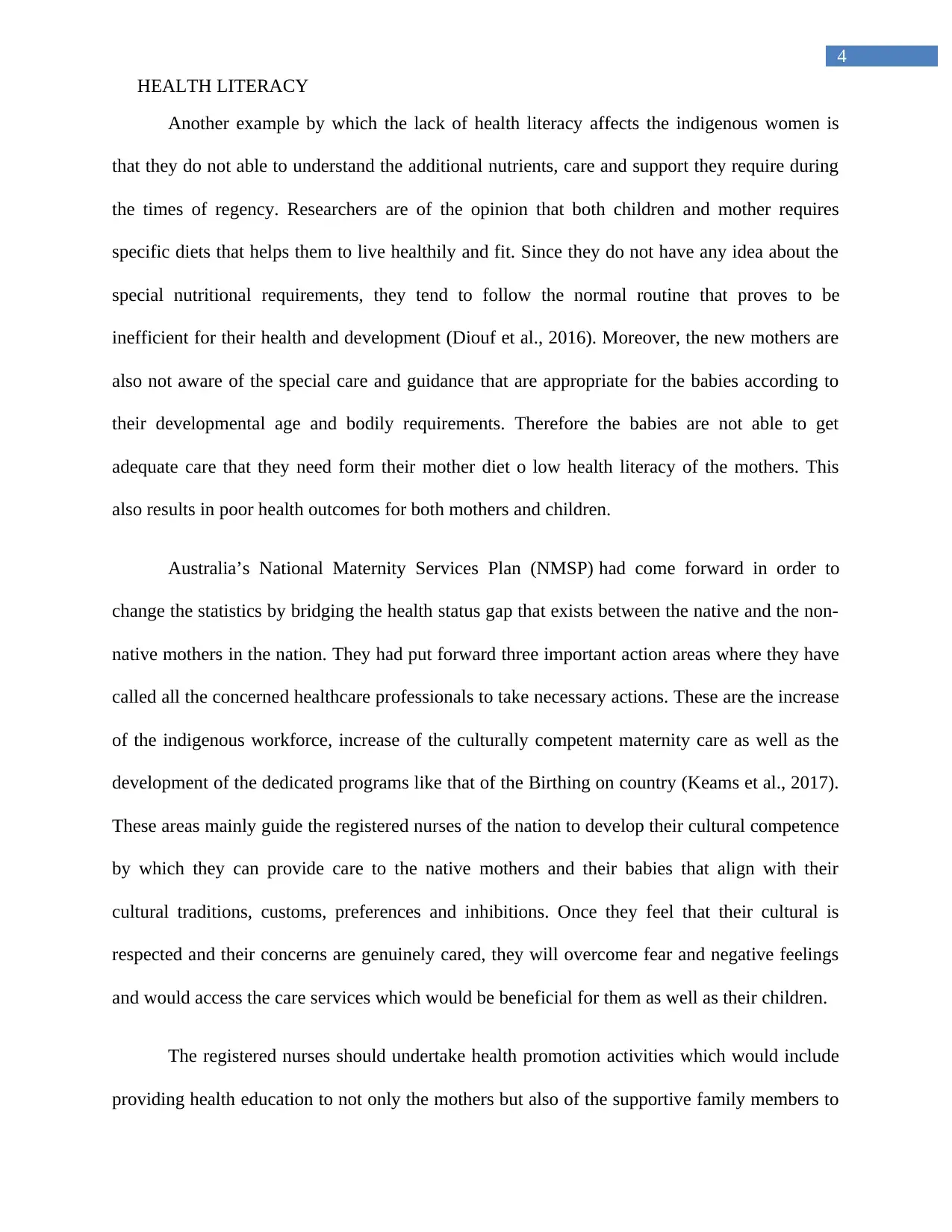
4
HEALTH LITERACY
Another example by which the lack of health literacy affects the indigenous women is
that they do not able to understand the additional nutrients, care and support they require during
the times of regency. Researchers are of the opinion that both children and mother requires
specific diets that helps them to live healthily and fit. Since they do not have any idea about the
special nutritional requirements, they tend to follow the normal routine that proves to be
inefficient for their health and development (Diouf et al., 2016). Moreover, the new mothers are
also not aware of the special care and guidance that are appropriate for the babies according to
their developmental age and bodily requirements. Therefore the babies are not able to get
adequate care that they need form their mother diet o low health literacy of the mothers. This
also results in poor health outcomes for both mothers and children.
Australia’s National Maternity Services Plan (NMSP) had come forward in order to
change the statistics by bridging the health status gap that exists between the native and the non-
native mothers in the nation. They had put forward three important action areas where they have
called all the concerned healthcare professionals to take necessary actions. These are the increase
of the indigenous workforce, increase of the culturally competent maternity care as well as the
development of the dedicated programs like that of the Birthing on country (Keams et al., 2017).
These areas mainly guide the registered nurses of the nation to develop their cultural competence
by which they can provide care to the native mothers and their babies that align with their
cultural traditions, customs, preferences and inhibitions. Once they feel that their cultural is
respected and their concerns are genuinely cared, they will overcome fear and negative feelings
and would access the care services which would be beneficial for them as well as their children.
The registered nurses should undertake health promotion activities which would include
providing health education to not only the mothers but also of the supportive family members to
HEALTH LITERACY
Another example by which the lack of health literacy affects the indigenous women is
that they do not able to understand the additional nutrients, care and support they require during
the times of regency. Researchers are of the opinion that both children and mother requires
specific diets that helps them to live healthily and fit. Since they do not have any idea about the
special nutritional requirements, they tend to follow the normal routine that proves to be
inefficient for their health and development (Diouf et al., 2016). Moreover, the new mothers are
also not aware of the special care and guidance that are appropriate for the babies according to
their developmental age and bodily requirements. Therefore the babies are not able to get
adequate care that they need form their mother diet o low health literacy of the mothers. This
also results in poor health outcomes for both mothers and children.
Australia’s National Maternity Services Plan (NMSP) had come forward in order to
change the statistics by bridging the health status gap that exists between the native and the non-
native mothers in the nation. They had put forward three important action areas where they have
called all the concerned healthcare professionals to take necessary actions. These are the increase
of the indigenous workforce, increase of the culturally competent maternity care as well as the
development of the dedicated programs like that of the Birthing on country (Keams et al., 2017).
These areas mainly guide the registered nurses of the nation to develop their cultural competence
by which they can provide care to the native mothers and their babies that align with their
cultural traditions, customs, preferences and inhibitions. Once they feel that their cultural is
respected and their concerns are genuinely cared, they will overcome fear and negative feelings
and would access the care services which would be beneficial for them as well as their children.
The registered nurses should undertake health promotion activities which would include
providing health education to not only the mothers but also of the supportive family members to
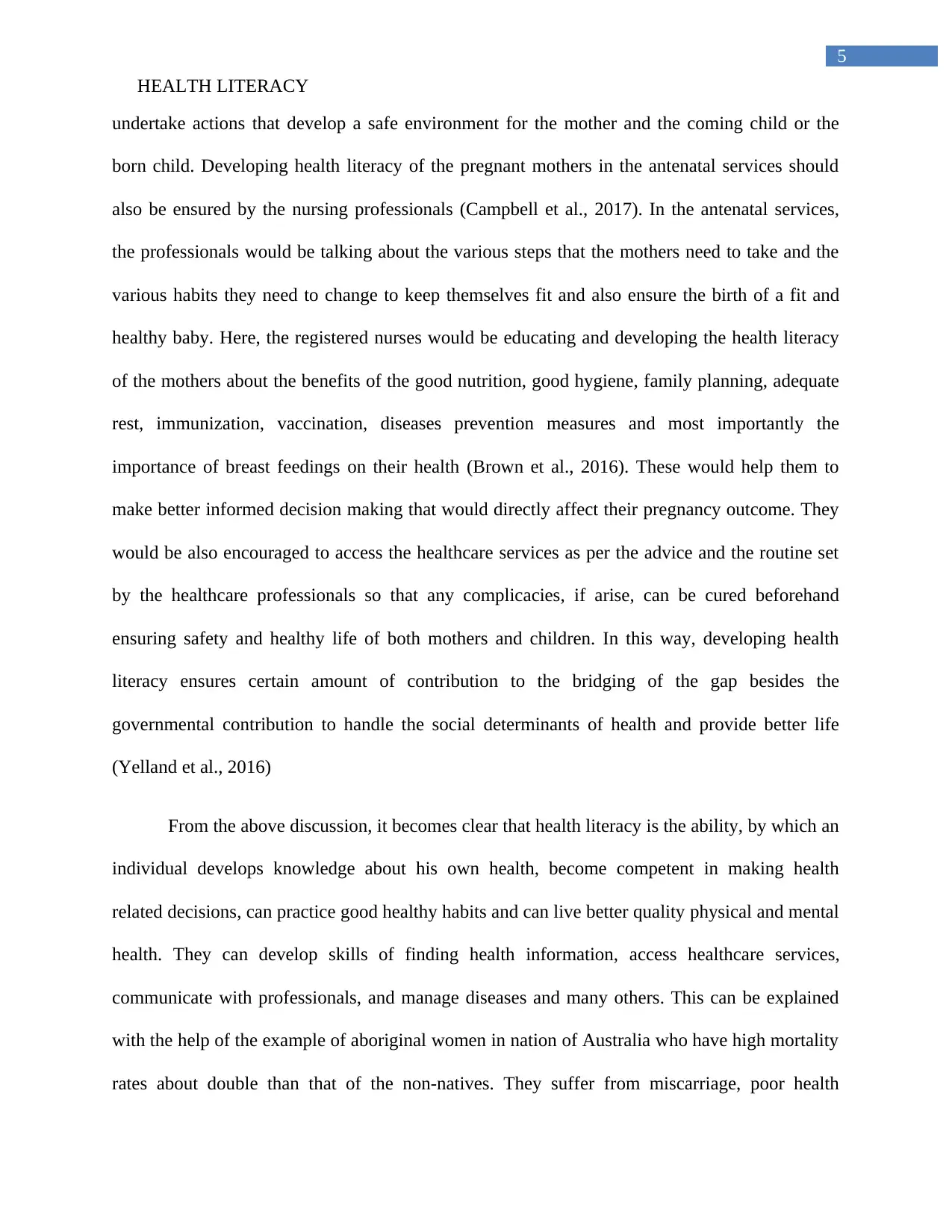
5
HEALTH LITERACY
undertake actions that develop a safe environment for the mother and the coming child or the
born child. Developing health literacy of the pregnant mothers in the antenatal services should
also be ensured by the nursing professionals (Campbell et al., 2017). In the antenatal services,
the professionals would be talking about the various steps that the mothers need to take and the
various habits they need to change to keep themselves fit and also ensure the birth of a fit and
healthy baby. Here, the registered nurses would be educating and developing the health literacy
of the mothers about the benefits of the good nutrition, good hygiene, family planning, adequate
rest, immunization, vaccination, diseases prevention measures and most importantly the
importance of breast feedings on their health (Brown et al., 2016). These would help them to
make better informed decision making that would directly affect their pregnancy outcome. They
would be also encouraged to access the healthcare services as per the advice and the routine set
by the healthcare professionals so that any complicacies, if arise, can be cured beforehand
ensuring safety and healthy life of both mothers and children. In this way, developing health
literacy ensures certain amount of contribution to the bridging of the gap besides the
governmental contribution to handle the social determinants of health and provide better life
(Yelland et al., 2016)
From the above discussion, it becomes clear that health literacy is the ability, by which an
individual develops knowledge about his own health, become competent in making health
related decisions, can practice good healthy habits and can live better quality physical and mental
health. They can develop skills of finding health information, access healthcare services,
communicate with professionals, and manage diseases and many others. This can be explained
with the help of the example of aboriginal women in nation of Australia who have high mortality
rates about double than that of the non-natives. They suffer from miscarriage, poor health
HEALTH LITERACY
undertake actions that develop a safe environment for the mother and the coming child or the
born child. Developing health literacy of the pregnant mothers in the antenatal services should
also be ensured by the nursing professionals (Campbell et al., 2017). In the antenatal services,
the professionals would be talking about the various steps that the mothers need to take and the
various habits they need to change to keep themselves fit and also ensure the birth of a fit and
healthy baby. Here, the registered nurses would be educating and developing the health literacy
of the mothers about the benefits of the good nutrition, good hygiene, family planning, adequate
rest, immunization, vaccination, diseases prevention measures and most importantly the
importance of breast feedings on their health (Brown et al., 2016). These would help them to
make better informed decision making that would directly affect their pregnancy outcome. They
would be also encouraged to access the healthcare services as per the advice and the routine set
by the healthcare professionals so that any complicacies, if arise, can be cured beforehand
ensuring safety and healthy life of both mothers and children. In this way, developing health
literacy ensures certain amount of contribution to the bridging of the gap besides the
governmental contribution to handle the social determinants of health and provide better life
(Yelland et al., 2016)
From the above discussion, it becomes clear that health literacy is the ability, by which an
individual develops knowledge about his own health, become competent in making health
related decisions, can practice good healthy habits and can live better quality physical and mental
health. They can develop skills of finding health information, access healthcare services,
communicate with professionals, and manage diseases and many others. This can be explained
with the help of the example of aboriginal women in nation of Australia who have high mortality
rates about double than that of the non-natives. They suffer from miscarriage, poor health
⊘ This is a preview!⊘
Do you want full access?
Subscribe today to unlock all pages.

Trusted by 1+ million students worldwide

6
HEALTH LITERACY
outcomes, obstetric hemorrhage, mal nutrition, ectopic pregnancy, abortion and many others and
the children are seen to suffer too. One of these contributing factors is poor health literacy like
improper knowledge about taking good care of self and children, proper diets, improper
unhealthy behaviors like smoking and alcohol and many others. Therefore registered nurses
should undertake health promotions, health education and health literacy development
campaigns so that they can bridge the gap ensuring better quality life of such women.
HEALTH LITERACY
outcomes, obstetric hemorrhage, mal nutrition, ectopic pregnancy, abortion and many others and
the children are seen to suffer too. One of these contributing factors is poor health literacy like
improper knowledge about taking good care of self and children, proper diets, improper
unhealthy behaviors like smoking and alcohol and many others. Therefore registered nurses
should undertake health promotions, health education and health literacy development
campaigns so that they can bridge the gap ensuring better quality life of such women.
Paraphrase This Document
Need a fresh take? Get an instant paraphrase of this document with our AI Paraphraser
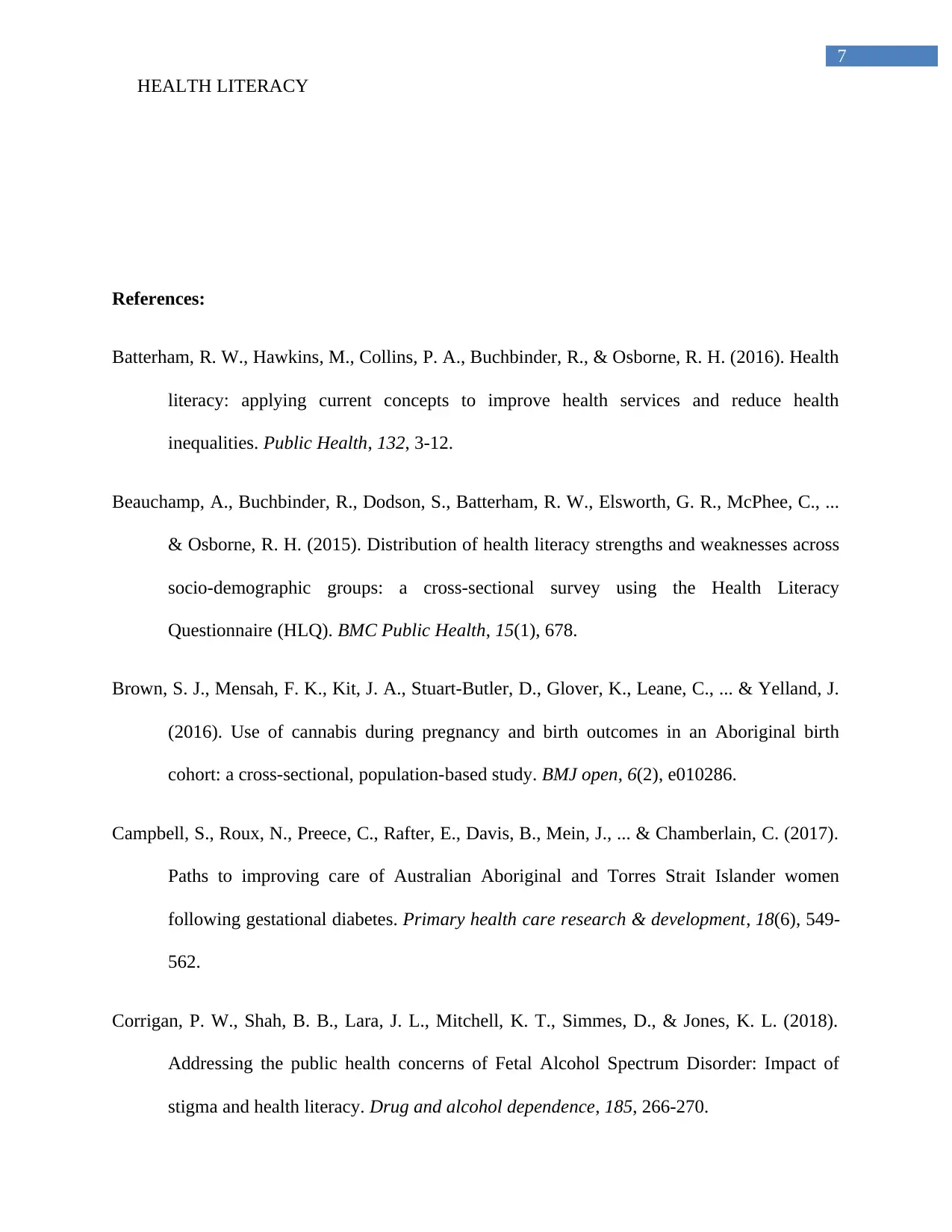
7
HEALTH LITERACY
References:
Batterham, R. W., Hawkins, M., Collins, P. A., Buchbinder, R., & Osborne, R. H. (2016). Health
literacy: applying current concepts to improve health services and reduce health
inequalities. Public Health, 132, 3-12.
Beauchamp, A., Buchbinder, R., Dodson, S., Batterham, R. W., Elsworth, G. R., McPhee, C., ...
& Osborne, R. H. (2015). Distribution of health literacy strengths and weaknesses across
socio-demographic groups: a cross-sectional survey using the Health Literacy
Questionnaire (HLQ). BMC Public Health, 15(1), 678.
Brown, S. J., Mensah, F. K., Kit, J. A., Stuart-Butler, D., Glover, K., Leane, C., ... & Yelland, J.
(2016). Use of cannabis during pregnancy and birth outcomes in an Aboriginal birth
cohort: a cross-sectional, population-based study. BMJ open, 6(2), e010286.
Campbell, S., Roux, N., Preece, C., Rafter, E., Davis, B., Mein, J., ... & Chamberlain, C. (2017).
Paths to improving care of Australian Aboriginal and Torres Strait Islander women
following gestational diabetes. Primary health care research & development, 18(6), 549-
562.
Corrigan, P. W., Shah, B. B., Lara, J. L., Mitchell, K. T., Simmes, D., & Jones, K. L. (2018).
Addressing the public health concerns of Fetal Alcohol Spectrum Disorder: Impact of
stigma and health literacy. Drug and alcohol dependence, 185, 266-270.
HEALTH LITERACY
References:
Batterham, R. W., Hawkins, M., Collins, P. A., Buchbinder, R., & Osborne, R. H. (2016). Health
literacy: applying current concepts to improve health services and reduce health
inequalities. Public Health, 132, 3-12.
Beauchamp, A., Buchbinder, R., Dodson, S., Batterham, R. W., Elsworth, G. R., McPhee, C., ...
& Osborne, R. H. (2015). Distribution of health literacy strengths and weaknesses across
socio-demographic groups: a cross-sectional survey using the Health Literacy
Questionnaire (HLQ). BMC Public Health, 15(1), 678.
Brown, S. J., Mensah, F. K., Kit, J. A., Stuart-Butler, D., Glover, K., Leane, C., ... & Yelland, J.
(2016). Use of cannabis during pregnancy and birth outcomes in an Aboriginal birth
cohort: a cross-sectional, population-based study. BMJ open, 6(2), e010286.
Campbell, S., Roux, N., Preece, C., Rafter, E., Davis, B., Mein, J., ... & Chamberlain, C. (2017).
Paths to improving care of Australian Aboriginal and Torres Strait Islander women
following gestational diabetes. Primary health care research & development, 18(6), 549-
562.
Corrigan, P. W., Shah, B. B., Lara, J. L., Mitchell, K. T., Simmes, D., & Jones, K. L. (2018).
Addressing the public health concerns of Fetal Alcohol Spectrum Disorder: Impact of
stigma and health literacy. Drug and alcohol dependence, 185, 266-270.
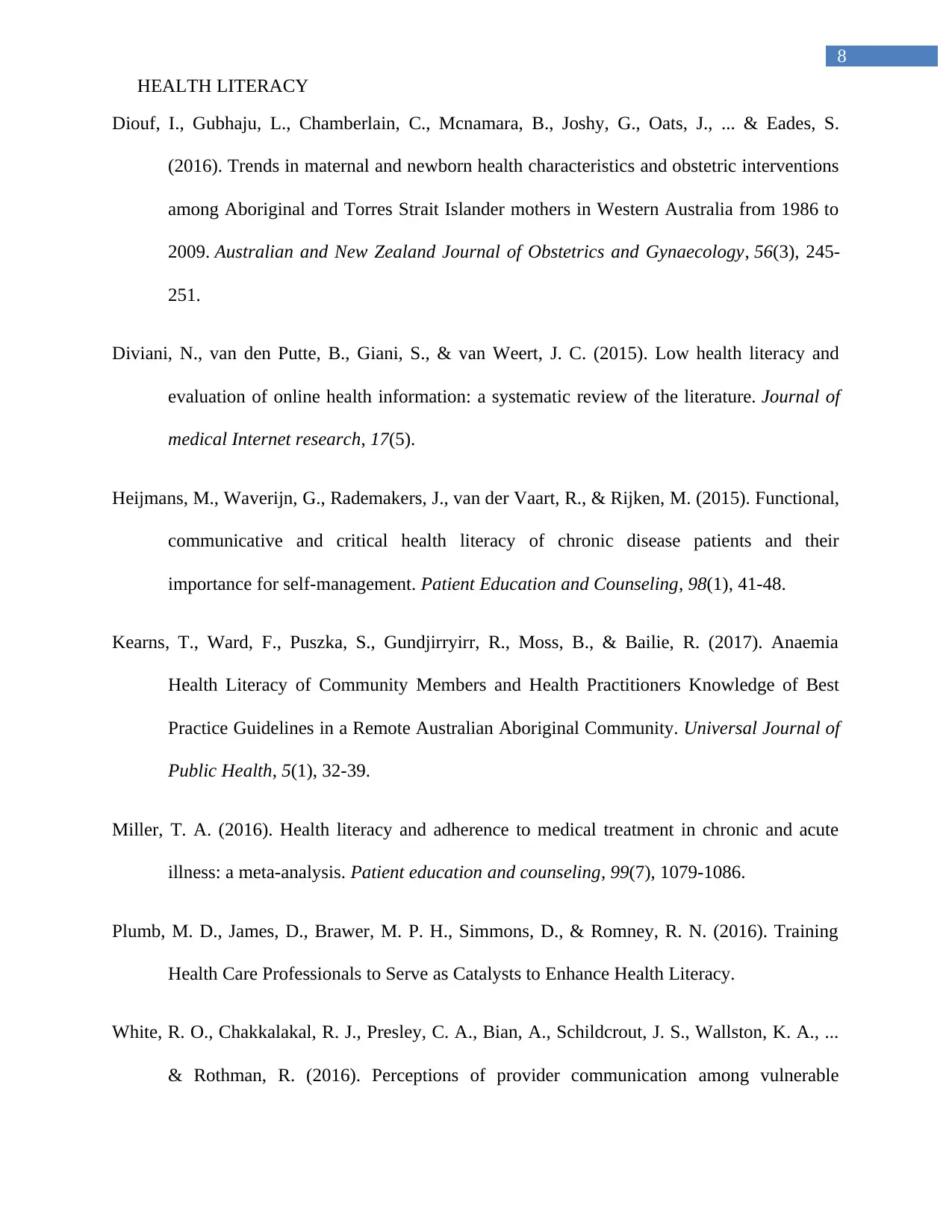
8
HEALTH LITERACY
Diouf, I., Gubhaju, L., Chamberlain, C., Mcnamara, B., Joshy, G., Oats, J., ... & Eades, S.
(2016). Trends in maternal and newborn health characteristics and obstetric interventions
among Aboriginal and Torres Strait Islander mothers in Western Australia from 1986 to
2009. Australian and New Zealand Journal of Obstetrics and Gynaecology, 56(3), 245-
251.
Diviani, N., van den Putte, B., Giani, S., & van Weert, J. C. (2015). Low health literacy and
evaluation of online health information: a systematic review of the literature. Journal of
medical Internet research, 17(5).
Heijmans, M., Waverijn, G., Rademakers, J., van der Vaart, R., & Rijken, M. (2015). Functional,
communicative and critical health literacy of chronic disease patients and their
importance for self-management. Patient Education and Counseling, 98(1), 41-48.
Kearns, T., Ward, F., Puszka, S., Gundjirryirr, R., Moss, B., & Bailie, R. (2017). Anaemia
Health Literacy of Community Members and Health Practitioners Knowledge of Best
Practice Guidelines in a Remote Australian Aboriginal Community. Universal Journal of
Public Health, 5(1), 32-39.
Miller, T. A. (2016). Health literacy and adherence to medical treatment in chronic and acute
illness: a meta-analysis. Patient education and counseling, 99(7), 1079-1086.
Plumb, M. D., James, D., Brawer, M. P. H., Simmons, D., & Romney, R. N. (2016). Training
Health Care Professionals to Serve as Catalysts to Enhance Health Literacy.
White, R. O., Chakkalakal, R. J., Presley, C. A., Bian, A., Schildcrout, J. S., Wallston, K. A., ...
& Rothman, R. (2016). Perceptions of provider communication among vulnerable
HEALTH LITERACY
Diouf, I., Gubhaju, L., Chamberlain, C., Mcnamara, B., Joshy, G., Oats, J., ... & Eades, S.
(2016). Trends in maternal and newborn health characteristics and obstetric interventions
among Aboriginal and Torres Strait Islander mothers in Western Australia from 1986 to
2009. Australian and New Zealand Journal of Obstetrics and Gynaecology, 56(3), 245-
251.
Diviani, N., van den Putte, B., Giani, S., & van Weert, J. C. (2015). Low health literacy and
evaluation of online health information: a systematic review of the literature. Journal of
medical Internet research, 17(5).
Heijmans, M., Waverijn, G., Rademakers, J., van der Vaart, R., & Rijken, M. (2015). Functional,
communicative and critical health literacy of chronic disease patients and their
importance for self-management. Patient Education and Counseling, 98(1), 41-48.
Kearns, T., Ward, F., Puszka, S., Gundjirryirr, R., Moss, B., & Bailie, R. (2017). Anaemia
Health Literacy of Community Members and Health Practitioners Knowledge of Best
Practice Guidelines in a Remote Australian Aboriginal Community. Universal Journal of
Public Health, 5(1), 32-39.
Miller, T. A. (2016). Health literacy and adherence to medical treatment in chronic and acute
illness: a meta-analysis. Patient education and counseling, 99(7), 1079-1086.
Plumb, M. D., James, D., Brawer, M. P. H., Simmons, D., & Romney, R. N. (2016). Training
Health Care Professionals to Serve as Catalysts to Enhance Health Literacy.
White, R. O., Chakkalakal, R. J., Presley, C. A., Bian, A., Schildcrout, J. S., Wallston, K. A., ...
& Rothman, R. (2016). Perceptions of provider communication among vulnerable
⊘ This is a preview!⊘
Do you want full access?
Subscribe today to unlock all pages.

Trusted by 1+ million students worldwide
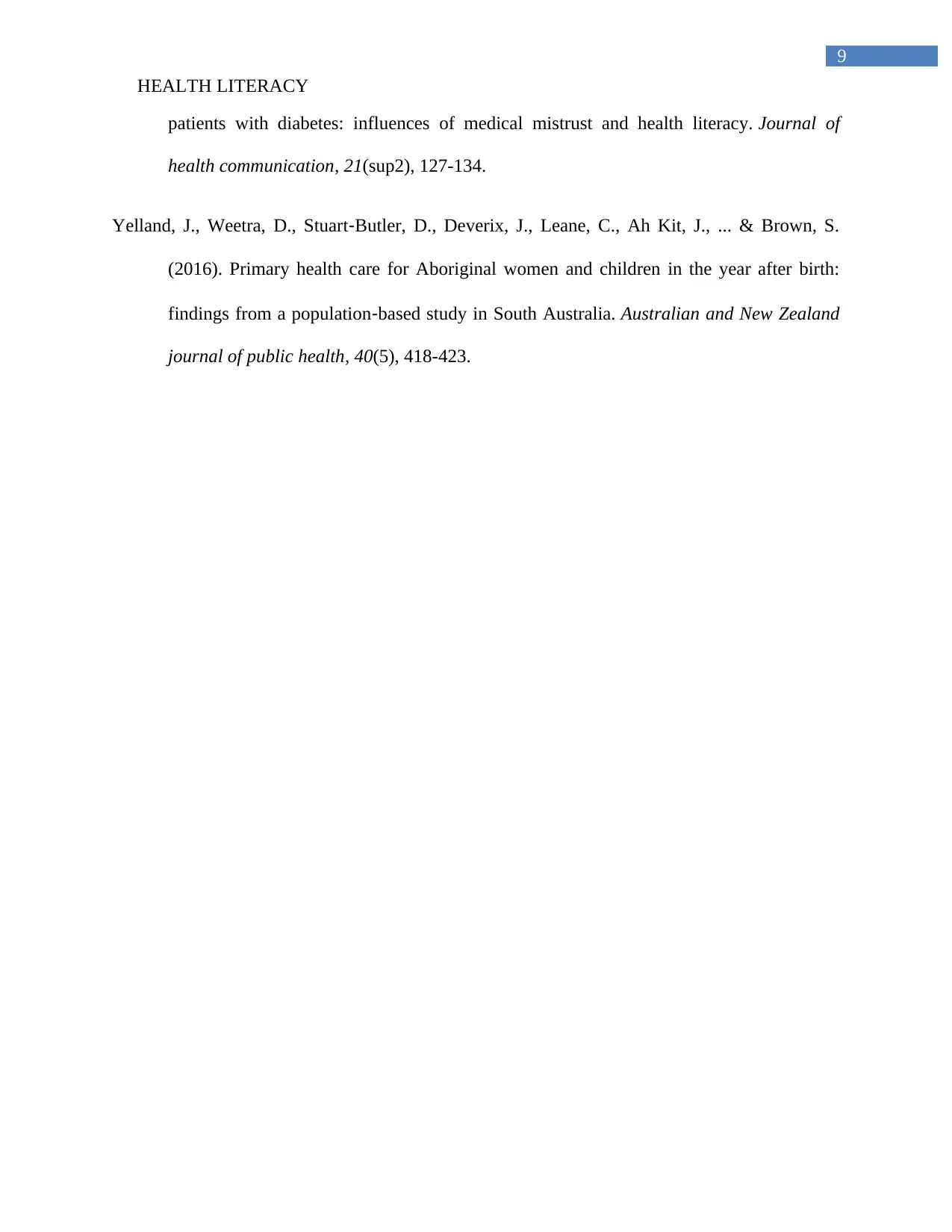
9
HEALTH LITERACY
patients with diabetes: influences of medical mistrust and health literacy. Journal of
health communication, 21(sup2), 127-134.
Yelland, J., Weetra, D., Stuart‐Butler, D., Deverix, J., Leane, C., Ah Kit, J., ... & Brown, S.
(2016). Primary health care for Aboriginal women and children in the year after birth:
findings from a population‐based study in South Australia. Australian and New Zealand
journal of public health, 40(5), 418-423.
HEALTH LITERACY
patients with diabetes: influences of medical mistrust and health literacy. Journal of
health communication, 21(sup2), 127-134.
Yelland, J., Weetra, D., Stuart‐Butler, D., Deverix, J., Leane, C., Ah Kit, J., ... & Brown, S.
(2016). Primary health care for Aboriginal women and children in the year after birth:
findings from a population‐based study in South Australia. Australian and New Zealand
journal of public health, 40(5), 418-423.
1 out of 10
Related Documents
Your All-in-One AI-Powered Toolkit for Academic Success.
+13062052269
info@desklib.com
Available 24*7 on WhatsApp / Email
![[object Object]](/_next/static/media/star-bottom.7253800d.svg)
Unlock your academic potential
Copyright © 2020–2025 A2Z Services. All Rights Reserved. Developed and managed by ZUCOL.





